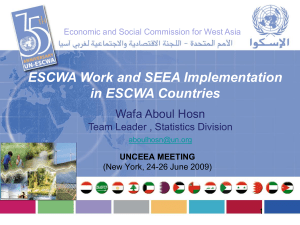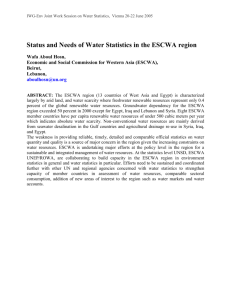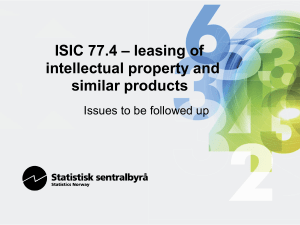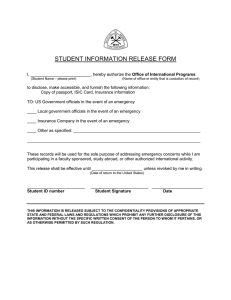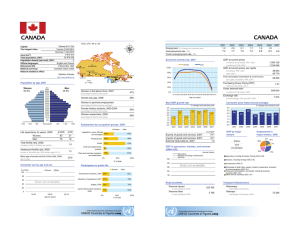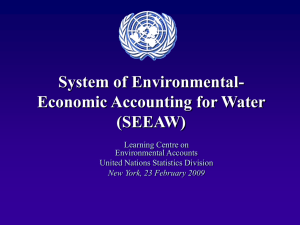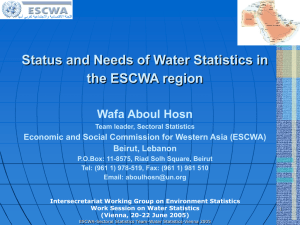ESCWA Work and SEEA Implementation in ESCWA Countries Wafa Aboul Hosn
advertisement
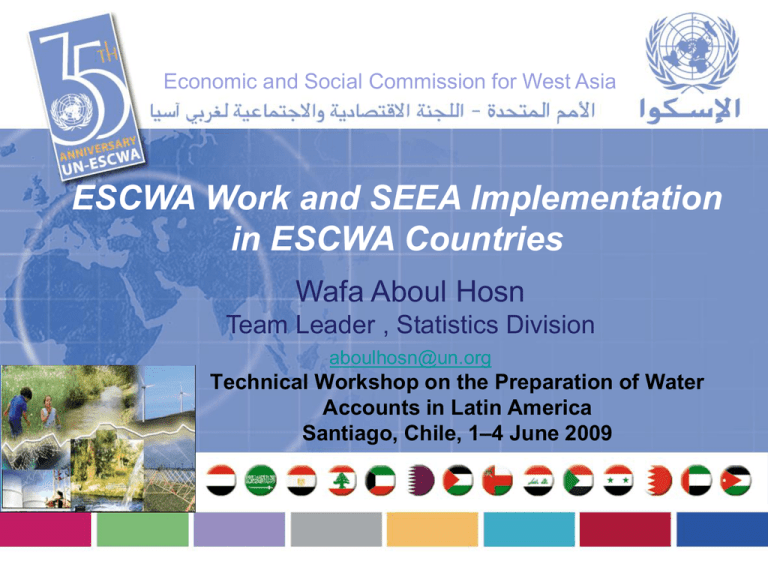
Economic and Social Commission for West Asia ESCWA Work and SEEA Implementation in ESCWA Countries Wafa Aboul Hosn Team Leader , Statistics Division aboulhosn@un.org Technical Workshop on the Preparation of Water Accounts in Latin America Santiago, Chile, 1–4 June 2009 Strengthening National Capacities in Environment Statistics, Indicators and Accounts (ESIA) in the ESCWA and ECLAC Regions 2007-2009 OBJECTIVES • To strengthen National Capacities of ESCWA countries in the collection, coverage, dissemination and exchange of reliable, timely and comparable environment statistics, indicators, and accounts (ES) • To take advantage of an integrated environmental statistical system approach in support of progress toward achieving national and internationally agreed development goals. Activities of the Project • • • • • Regional training sessions Subregional workshops Technical assistance missions Expert group meetings Methodological documents on integrated environmental statistical systems • Database, docubase, and expertbase on environment information • Study tours ESCWA-ESIA project 2008-2009 4 The Network The Forum ESCWA-ESIA project 2008-2009 5 Subregion1 ABOUT ESCWA COUNTRIES Egypt, Iraq, Lebanon , Syria, Sudan Surface Water Shared Water Resources Subregion2 Arabian Peninsula Jordan, Palestine (about 200 m3/yr/capita) Limited Surface Water Ground Water (Fresh vs. Brackish) (Fossil vs. Renewable) (Desalination) Hard to Measure Water Assets Water Use Water Supply Economics of Water: Cost Subsidies, Taxes Water Assets Estimation groundwater, and recharge Water Use Water Supply Social Problems Economics of Water: Pilot Water Accounts Egypt, Lebanon 1st Step Pilot Water Accounts Jordan, Oman, Bahrain, Palestine Cost, Subsidies, Taxes Market values SEEA-W A STEP FORWARD! Frameworks, Classifications, Methods: Water Data WATER SCACITY in the ESCWA region requires data on water in the most efficient way Frameworks Water Statistics Quantities, Quality, Flow, Access Water Indicators CSD-WRI-PSIR IWRM Accounting Framework SEEAW Derive Most Indicators International Organize Classification Store Assess Present quality/ data into Manage information SEEA Pilot Studies 1. 2. 3. 4. 5. Jordan Lebanon Oman Bahrain Egypt JORDAN: Water Challenges • Scarcity of fresh renewable water resources: Per capita water supply is around 145 m3/day in 2005 and expected to be 90 m3/year in 2025 • Overexploitation of renewable and non renewable ground water • High population number and forced immigration • Limited capacity of waste water plants • High losses of water supply to municipal sector during distribution (public net work) 50 % as a result of leakages, theft, illegal tapping & malfunctioning metering. • Limited capacity and number of dams 9 dams with storage capacity around 210 MCM • Over 91 percent of the country receives less than 200 mm of rainfall per year • Limited capacity of waste water treatment plants Jordan – Implementation of SEEAW • February 2007 – Med Stat II Workshop. The Department of Statistics begins work on water accounting • June 2007 – Simplified physical supply and use table and presented at ESCWA Expert Group Meeting, Cairo, Egypt. • June 2007 – UNSD mission to Jordan. Tables revised and training of DOS staff • March 2008 – Med Stat II/ESCWA/UNSD workshop. Draft tables and analysis presented • May 2008 – Draft report review by UNSD. • The Department of Statistics and Ministry of Water Resources and Ministry of Environment developing a plan on-going production of water accounts • March 2009 – Pilot Water Accounts revision and preparation for final submission JORDAN Physical use table,2007 Industries (by ISIC categories) From the environme nt Within the economy Househol ds 1 36 37 others Total U1 - Total abstraction 506 294 0.0 49.0 849 0.0 849 a.1- Abstraction for own use 506 0.0 0.0 49.0 555 0.0 555 a.2- Abstraction for distribution 0.0 294 0.0 0.0 249 0.0 249 b.1- From water resources: 506 294 0.0 49.0 849 0.0 849 * Surface water 261 80 0.0 4.0 345 0.0 345 * Groundwater 245 214 0.0 45.0 504 0.0 504 *Soil water 0.0 0.0 0.0 0.0 0.0 0.0 0.0 b.2- From other sources 0.0 0.0 0.0 0.0 0.0 0.0 0.0 * Collection of precipitation 0.0 0.0 0.0 0.0 0.0 0.0 0.0 * Abstraction from the sea 0.0 0.0 0.0 0.0 0.0 0.0 0.0 U2 - Use of water received from other economic units 91 0.0 113 0.0 202 147 351 of which: Reused water 91 0.0 0.0 0.0 91 0.0 91 0.0 0.0 113 0.0 113 0.0 113 Wastewater to sewerage Total use of water = U1+U2= Total 1200 JORDAN Physical Supply table,2007 Industries (by ISIC categories) Within the economy To the Environment 1 36 37 other s S1- Supply of water to other economic units 0.0 147 91 23 271 90 351 of which: Reused water 91 0.0 0.0 0.0 91 0.0 91 Wastewater to sewerage 0.0 0.0 0.0 23 23 90 113 S2- total returns= (D1+D2) 60 140 6 5 211 0.0 211 D1- to water resources 60 140 6 5 211 0.0 211 * surface water 5 10 6 5 23 0.0 23 * ground water 50 10 0.0 0.0 60 0.0 60 5 120 0.0 0.0 125 0.0 125 0.0 0.0 0.0 0.0 0.0 0.0 0.0 * soil water D2- to other sources Total Househol ds Total Total supply of water = S1+S2= 562 Water consumption= total use – total supply 638 Water Indicators • Total ground water abstraction. Value of indicator 2007: 504(MCM) • Safe yield of renewable ground water. Value of indicator 2007: 275(MCM) • Overexploitation of ground water ( Depletion) or ground water balance. Value of indicator 2007: -229(MCM) • % of depletion of ground water or % of safe yield. Value of indicator 2007: 183%. Pilot Water accounts for Oman Preliminary data assessment • Much water data already exists in government and private sector reports • Supply side data appears good • Use side data is less well developed • Terms and definitions appear to differ between data sources • Industry aggregations are different between data sources Some specific data gaps and deficiencies In the national accounts • The water and electricity supply are combined • The sewerage industry is combined with other industries • Value of fixed capital for water supply and sewerage is not known • Costs of water supply and sewerage for own use are not known • Sub-national data are not published In the physical water data • Volume of water extracted from wells is poorly known • Industry aggregations are not consistent with ISIC and are less detailed than the national accounts • Only limited economic data (e.g. on revenues from sales or government subsidy) are published Trial population of standard physical supply and use diagram Sewerage ISIC 37 19.03 Agriculture ISIC 1 1126 Forestry and Fishing ISIC 2,3 Mining ISIC 5, 7-9 Extraction of crude petroleum ISIC 6 Manufacturing ISIC 10-18, 20-33, 41-43 Manufacturing refined petroleum ISIC 19 151.2 Inland water resources (fresh surface water and groundwater) Water Wastewater Reuse water Electricity ISI Suggested implementation Plan for Oman September 2008 • Establishment of High level steering committee – Clarification of roles and responsibilities for data production and compilation of accounts – Allocation or resources. Need one person, ideally full time, to be responsible for the compilation of the accounts • Nomination of focal points and establishment of working group October-December 2008 • Trial population of standard tables for national level (if resources allow for one or more regions) – Physical supply and use tables, Hybrid supply and use tables , Asset account • Preliminary analysis of data, including a detailed data quality assessment of existing data sources January 2009 – Circulation of trial tables and preliminary analysis February – March 2009 – Revise tables and analysis for publication – Prepare plan for on-going production of accounts, including a cost-effective way to address data deficiencies and gaps April-May 2009 – Publish trial accounts and analysis – Begin to implement plan for on-going production of water accounts Pilot Water accounts for Bahrain Industrial 5-33 41-43 4 5 Losses .5 104.5 104 Desalination plant Losses 1 Water Supply Industry ISIC 36 5 Mean Annual Water Consumption for All Uses (million cubic meters) 148.5 Treated Water Desalinated Water 50 47 314 9 156 149 3 48 49 322 10 156 156 3 48 49 329 10 158 161 19 99 4.4 19 106 4.8 21 110 4.9 TOTAL 1.9 2.2 2.0 2.2 2.2 2.4 2.5 2.8 2.6 2.7 2.4 2.7 2.6 2.7 2.8 3.7 4.1 4.1 YEAR 3 43 50 44 49 49 54 56 62 58 60 53 59 58 60 61 81 90 91 Population*1000 0 0 0 2 2 4 6 8 8 11 12 13 13 12 14 15 15 16 DOMESTIC 85 90 95 99 105 107 105 109 116 115 112 114 116 119 121 130 138 141 Mean Domestic Use per Capita 100 109 118 110 117 128 128 144 148 163 171 183 192 193 185 175 154 158 AGRICULTURE AGRICULTURE 7 8 8 8 8 8 8 8 9 9 9 10 10 10 9 10 9 9 TOTAL DOMESTIC 192 207 220 217 230 243 241 262 273 287 292 307 318 322 315 315 301 309 IMDUSTRIAL AGRICULTURE 44 43 43 46 46 44 44 42 43 40 38 37 37 37 38 41 46 46 DOMESTIC TOTAL IMDUSTRIAL 52 53 53 51 51 53 53 55 54 57 59 60 60 60 59 56 51 51 Losses .5 7 120.5 AGRICULTURE DOMESTIC L/D Total Losses 28 IMDUSTRIAL IMDUSTRIAL AGRICULTURE 4 4 3 4 3 3 3 3 3 3 3 3 3 3 3 3 3 3 49.5 GroundWater X 1000 Grand total % use 0.4 0.5 0.4 0.5 0.5 0.5 0.6 0.6 0.6 0.6 0.5 0.6 0.6 0.6 0.6 0.8 0.9 0.9 41.0 47.4 42.2 47.0 46.4 51.7 53.5 59.1 55.7 57.1 50.1 56.7 55.2 57.3 58.5 77.6 86.0 87.3 149 157 176 166 178 184 178 192 205 215 227 233 247 250 239 219 195 201 5 5 6 6 6 6 5 6 6 6 7 7 7 8 6 6 5 5 100 109 117 108 114 123 121 136 139 151 159 169 178 181 170 160 137 142 44 42 53 52 58 55 51 50 60 58 62 57 61 62 62 53 52 54 573 596 617 634 656 658 631 636 648 617 574 564 552 544 532 556 570 559 383 391 400 408 417 426 436 454 472 491 511 532 554 577 600 625 651 677 1985 1986 1987 1988 1989 1990 1991 1992 1993 1994 1995 1996 1997 1998 1999 2000 2001 2002 1.0 94.1 195 5 136 54 567 100.9 190 5 130 55 575 1.1 104.6 190 5 128 57 572 705 734 764 2003 1.1 2004 50 Domestic 7 Ground water 80 128 2005 Agriculture ISIC 01 Example BAHRAIN 2005 Abdulla Ali, Authority of Electricity and Water From Tables to Diagrams Presented in Beirut August 2008 21 Sewerage Treatment ISIC 37 Challenges in SEAA-W Implementation in MSs 1. Use of common concepts, definitions and classifications within and across countries 2. Quality of data 3. Established sustainable system for national coordination 4. Need for aggregate Indicator 5. Implementing Water Quality Accounts and Valuation Technical Problems: • Water Accounts at the watershed levels (Lebanon, Oman, Egypt) • Supply by water tankers, cooling water, desalination • Soil water, brackish water… Role of Organizations ESCWA, UNSD,UNEP,MEDSTAT • Sharing Water Data (UNSD-UNEP Questionnaire) • Verifying and checking data, contacting and followingup with countries fro clarifications and corrections • Conducting joint trainings and missions on Water Accounts (training material, bilingual, coordinated assistance) • Adding countries concerns and comments in manuals and recommendations • Web Portal on Environmental Accounting for ESCWA Countries Network, docubase and forum ESIAP.escwa.org.lb • Sharing lessons learned with other regions (ECLAC) Opportunities in SEEAW for ESCWA and ECLAC Countries WHAT WAS ACCOMPLISHED UNTIL NOW! 1. Countries can use available data and put it into the system allowing gaps to be identified and addressed. 2. Improved data quality by cross- checking the different standard tables 3. Strengthening coordination among national statistical offices and water and environment ministries 4. SEEA-W as agent in creation of regional networks WAY FORWARD LONGER TERM APPLICATIONS! 1. Integrating information for water policy and management 2. Link to economic information through SNA 3. Flexibility and expansion to accommodate regional needs (i.e. inclusion of tourism industry, separate identification of oil industries etc)
